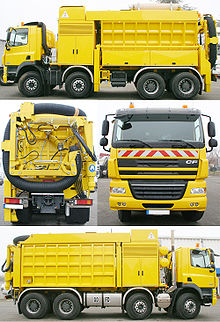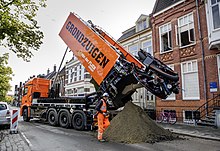This article has multiple issues. Please help improve it or discuss these issues on the talk page. (Learn how and when to remove these template messages)
|
A suction excavator, or vacuum excavator, is a construction vehicle that removes heavy debris or other materials from a hole on land using vacuuming. Suction excavators are meant to be more non-destructive than regular excavators.[1] The suction excavator uses suction fans for the airflow to suck up the material that is then transported into the holding tank.

Hydro excavation, a type of suction excavator using high-pressure water jets, is sometimes referred to as daylighting, as the underground utilities are exposed to daylight during the process.[2] Some suction excavators also use an air filter.
History edit
Since 1993, RSP UK Suction Excavators Ltd. has produced suction structures mounted onto two, three, and four-axle vehicles, stationary suction units, and custom-made machines.[3] Pacific Tek,[4] also founded in 1993, has created the Angled Vacuum Excavator Tank (1997) and the 180° Swivel Mount Valve Operator (1999).
In 1998, the Mobile Tiefbau Saugsysteme produced another type of suction excavator.[5]
The global market size for suction excavators was estimated to be valued at US$924.7 million in 2020.[6]
Uses edit
Suction excavators are sometimes used for removing earth around buried utilities and tree roots. It can suck up liquids, e.g., water from a hollow. Typically, vacuum excavation loosens the soil with a blunt-nosed high-pressure air lance or water source and vacuums away loosened material.

Depending on the machine used and soil conditions, a 12-inch-square, 5-foot-deep pothole can be completed in 20 minutes or less.[7] Vacuum excavation is sometimes used in conjunction with conventional underground (one-call) locating services. Because of overlapping buried utility lines, locating devices often miss some of the buried utilities on a site and cannot completely or accurately mark a site.
According to New Mexico 811's (NM811) Aligning Change, Locating with Potholing, "One-call paint marks and flags are the first steps in making the process of locating underground utilities safer, the use of vacuum excavation technology adds an additional margin of safety."[8]
See also edit
- Dredging
- Gully emptier
- Street sweeper
- Suction dredger, used for dredging underwater
- Suction (medicine)
References edit
External links edit
 Media related to Suction excavators at Wikimedia Commons
Media related to Suction excavators at Wikimedia Commons